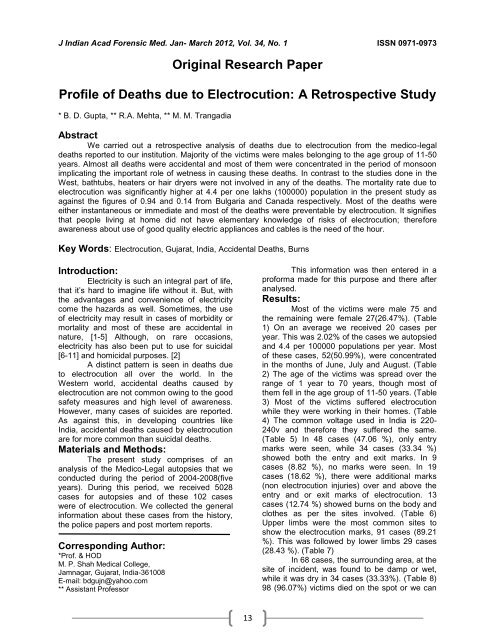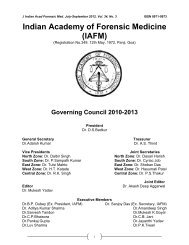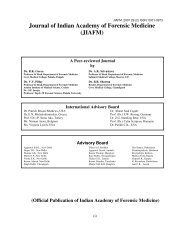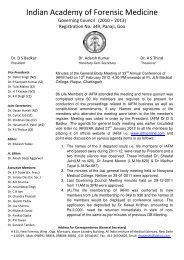Indian Academy of Forensic Medicine (IAFM) - Official website of IAFM
Indian Academy of Forensic Medicine (IAFM) - Official website of IAFM
Indian Academy of Forensic Medicine (IAFM) - Official website of IAFM
You also want an ePaper? Increase the reach of your titles
YUMPU automatically turns print PDFs into web optimized ePapers that Google loves.
J <strong>Indian</strong> Acad <strong>Forensic</strong> Med. Jan- March 2012, Vol. 34, No. 1 ISSN 0971-0973<br />
Original Research Paper<br />
Pr<strong>of</strong>ile <strong>of</strong> Deaths due to Electrocution: A Retrospective Study<br />
* B. D. Gupta, ** R.A. Mehta, ** M. M. Trangadia<br />
Abstract<br />
We carried out a retrospective analysis <strong>of</strong> deaths due to electrocution from the medico-legal<br />
deaths reported to our institution. Majority <strong>of</strong> the victims were males belonging to the age group <strong>of</strong> 11-50<br />
years. Almost all deaths were accidental and most <strong>of</strong> them were concentrated in the period <strong>of</strong> monsoon<br />
implicating the important role <strong>of</strong> wetness in causing these deaths. In contrast to the studies done in the<br />
West, bathtubs, heaters or hair dryers were not involved in any <strong>of</strong> the deaths. The mortality rate due to<br />
electrocution was significantly higher at 4.4 per one lakhs (100000) population in the present study as<br />
against the figures <strong>of</strong> 0.94 and 0.14 from Bulgaria and Canada respectively. Most <strong>of</strong> the deaths were<br />
either instantaneous or immediate and most <strong>of</strong> the deaths were preventable by electrocution. It signifies<br />
that people living at home did not have elementary knowledge <strong>of</strong> risks <strong>of</strong> electrocution; therefore<br />
awareness about use <strong>of</strong> good quality electric appliances and cables is the need <strong>of</strong> the hour.<br />
Key Words: Electrocution, Gujarat, India, Accidental Deaths, Burns<br />
Introduction:<br />
Electricity is such an integral part <strong>of</strong> life,<br />
that it’s hard to imagine life without it. But, with<br />
the advantages and convenience <strong>of</strong> electricity<br />
come the hazards as well. Sometimes, the use<br />
<strong>of</strong> electricity may result in cases <strong>of</strong> morbidity or<br />
mortality and most <strong>of</strong> these are accidental in<br />
nature, [1-5] Although, on rare occasions,<br />
electricity has also been put to use for suicidal<br />
[6-11] and homicidal purposes. [2]<br />
A distinct pattern is seen in deaths due<br />
to electrocution all over the world. In the<br />
Western world, accidental deaths caused by<br />
electrocution are not common owing to the good<br />
safety measures and high level <strong>of</strong> awareness.<br />
However, many cases <strong>of</strong> suicides are reported.<br />
As against this, in developing countries like<br />
India, accidental deaths caused by electrocution<br />
are for more common than suicidal deaths.<br />
Materials and Methods:<br />
The present study comprises <strong>of</strong> an<br />
analysis <strong>of</strong> the Medico-Legal autopsies that we<br />
conducted during the period <strong>of</strong> 2004-2008(five<br />
years). During this period, we received 5028<br />
cases for autopsies and <strong>of</strong> these 102 cases<br />
were <strong>of</strong> electrocution. We collected the general<br />
information about these cases from the history,<br />
the police papers and post mortem reports.<br />
Corresponding Author:<br />
*Pr<strong>of</strong>. & HOD<br />
M. P. Shah Medical College,<br />
Jamnagar, Gujarat, India-361008<br />
E-mail: bdgujn@yahoo.com<br />
** Assistant Pr<strong>of</strong>essor<br />
13<br />
This information was then entered in a<br />
pr<strong>of</strong>orma made for this purpose and there after<br />
analysed.<br />
Results:<br />
Most <strong>of</strong> the victims were male 75 and<br />
the remaining were female 27(26.47%). (Table<br />
1) On an average we received 20 cases per<br />
year. This was 2.02% <strong>of</strong> the cases we autopsied<br />
and 4.4 per 100000 populations per year. Most<br />
<strong>of</strong> these cases, 52(50.99%), were concentrated<br />
in the months <strong>of</strong> June, July and August. (Table<br />
2) The age <strong>of</strong> the victims was spread over the<br />
range <strong>of</strong> 1 year to 70 years, though most <strong>of</strong><br />
them fell in the age group <strong>of</strong> 11-50 years. (Table<br />
3) Most <strong>of</strong> the victims suffered electrocution<br />
while they were working in their homes. (Table<br />
4) The common voltage used in India is 220-<br />
240v and therefore they suffered the same.<br />
(Table 5) In 48 cases (47.06 %), only entry<br />
marks were seen, while 34 cases (33.34 %)<br />
showed both the entry and exit marks. In 9<br />
cases (8.82 %), no marks were seen. In 19<br />
cases (18.62 %), there were additional marks<br />
(non electrocution injuries) over and above the<br />
entry and or exit marks <strong>of</strong> electrocution. 13<br />
cases (12.74 %) showed burns on the body and<br />
clothes as per the sites involved. (Table 6)<br />
Upper limbs were the most common sites to<br />
show the electrocution marks, 91 cases (89.21<br />
%). This was followed by lower limbs 29 cases<br />
(28.43 %). (Table 7)<br />
In 68 cases, the surrounding area, at the<br />
site <strong>of</strong> incident, was found to be damp or wet,<br />
while it was dry in 34 cases (33.33%). (Table 8)<br />
98 (96.07%) victims died on the spot or we can









